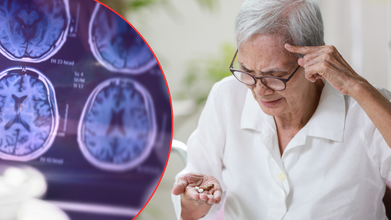- Health Conditions A-Z
- Health & Wellness
- Nutrition
- Fitness
- Health News
- Ayurveda
- Videos
- Medicine A-Z
- Parenting
- Web Stories
What Is A Polygenic Score And How It Could Reveal Your Future Breast Cancer Risk?

Credits: Canva
Breast cancer is the most frequently diagnosed cancer in women, accounting for over 15% of all new cancer cases in the United States. Abnormal cell growth in the breast ducts (DCIS) or lobules (LCIS) can sometimes progress to breast cancer, but currently, doctors cannot predict which cases will develop into invasive cancer.
A recent retrospective study using the 313-SNP breast cancer polygenic risk score (PRS313) blood test suggests that women with abnormal cells are more likely to be diagnosed with breast cancer later on. This discovery could help identify patients who would benefit from targeted interventions while reducing unnecessary treatments.
Although DCIS and LCIS can progress to breast cancer, predicting which cases will remain harmless has been a challenge. However, this new study indicates that calculating a polygenic score may help forecast a future breast cancer diagnosis.
“It is therefore very important that we find ways to predict which women with DCIS and LCIS are most likely to develop invasive breast cancer in the future so they can be given the most appropriate treatment and avoid unnecessary treatment,” explained study senior author Elinor J. Sawyer of King’s College London (UK).
What Is A Polygenic Score?
A polygenic score is a numerical estimate of a person’s genetic likelihood of developing a particular trait or disease. When used to predict disease risk, it is often called a polygenic risk score (PRS), according to Harvard Medicine Magazine.
Sawyer and study lead author Jasmine Timbres (King’s College London) focused on PRS313, a blood test that evaluates breast cancer risk by identifying which of 313 specific genetic variations (single nucleotide polymorphisms, or SNPs) a person carries. The researchers examined PRS313 scores from more than 2,000 DCIS and LCIS cases across the ICICLE and GLACIER studies.
Their findings showed that, for DCIS, women with higher PRS313 scores were 2.03 times more likely to develop cancer in the opposite breast compared to those in the lowest score quartile. For LCIS, women with elevated PRS313 scores were 2.16 times more likely to develop cancer in the same breast. The risk was even higher for patients with a family history of breast cancer.
“LCIS is not always treated with surgery or hormone therapy because it is considered lower risk than DCIS. However, these results suggest that women with a family history may benefit from additional interventions to reduce their risk of developing cancer,” Timbres added.
How To Measure A Polygenic Score?
A polygenic score is calculated by looking at an individual’s genetic variations (like SNPs) and summing them with weights based on how strongly each variant is associated with a trait or disease, as determined by large-scale genome-wide association studies (GWAS). Researchers first identify genetic variants linked to a disease by comparing the genomes of people with and without the condition. Each variant’s effect size is then applied to the individual’s genome to create a single score representing their overall genetic risk.
Polygenic scores can be measured in research settings using GWAS data. They are also available through commercial direct-to-consumer genetic testing services or via clinical assessments provided by medical institutions and genetic counselors.
Limitations Of The Study
While these findings are promising, further research is needed to confirm results in other patient groups and to examine additional genetic factors. Some limitations include the fact that PRS313 was designed specifically to assess risk for invasive breast cancer, meaning it may not capture other relevant genetic changes in in-situ breast disease. Additionally, the number of women with LCIS in the study was relatively small, which may have limited the ability to detect statistically significant associations.
Google Vs Chat GPT: Study Finds Which Medium Give Better Health Advice

(Credit-Canva)
Search engines like Google and Bing, and AI chatbots like ChatGPT and GPT-4, are now major sources of health information. But how reliable are they?
A new research published in the NPJ Digital Medicine tested four major search engines and seven different large AI models, including leading programs like ChatGPT and GPT-4, by asking them 150 medical questions. Their study looked at how accurate the answers were, how much the results changed based on how the question was asked, and whether giving the AI access to search results helped.
Which Gave Better Answers: AI or Search Engines?
While AI Chatbots, with 80% accuracy, generally outperformed Search Engines, with 50-70% accuracy, on direct health questions, the study found that AI chatbots are good, but their mistakes are worrying.
Confidence in Errors
The biggest and most dangerous problem was that the AI sometimes gave confidently wrong answers that directly disagreed with established medical facts. This is highly risky in a health setting.
Overall Accuracy
The AI chatbots generally did better than search engines, correctly answering about 80% of the questions. The best performers were typically GPT-4, ChatGPT, Llama3, and MedLlama3.
Precision Problem
Search engines like Google usually return answers that are correct when they directly address the question, but they often clutter the results with information that is incomplete or off-topic. They struggled with giving a straight "yes" or "no" answer.
User Habits
The study simulated a "lazy" user, who just trusts the first answer, and a "diligent" user, who checks three sources. Surprisingly, the "lazy" users were sometimes just as accurate as the diligent ones, suggesting that top-ranked results are often good, but this is a risk if a highly ranked answer happens to be wrong.
Bing was the best among search engines, but it wasn't significantly better than Google, Yahoo!, or DuckDuckGo.
How You Ask The Question Matters
The AI's accuracy was highly sensitive to how the question was phrased. Using an "expert" prompt like asking the AI to cite reputable medical sources generally led to better, more medically sound answers, even if they were sometimes less direct.
Giving the AI the top search results before it answered (retrieval augmentation) usually improved performance, especially for smaller AI models. However, this didn't always help; if the search results given to the AI were irrelevant or low-quality, the AI's answer could actually get worse. More information isn't always better.
Things to Keep In Mind
Some points noted by the researchers was,
- Questions about COVID-19 were easier for both AI and search engines, likely because of the huge amount of data available about the pandemic.
- While AI is powerful, its tendency to be swayed by how you word the question and its confident errors mean we need to be very cautious about using it for medical advice.
- The overall conclusion is that AI models are promising for health information, but they are not yet fully reliable on their own. Combining them with high-quality search results is likely the best way forward, but only if the search results fed to the AI are trustworthy.
Eye Movement Tracker Can Reveal The Risk Of Alzheimer's Years Before Symptoms Appear: Study

(Credit-Canva)
A recent scientific study found an exciting new way to check if someone is likely to get Alzheimer's disease due to their genetics. Instead of current medical tests, which are often costly, complex, and invasive, this new method uses simple eye-tracking technology. This means diagnosing the risk could become much easier for patients and more affordable for healthcare systems.
As you may know, there is currently no cure for Alzheimer's disease. This is a neurodegenerative disease that can affect a person’s memory, skills, as well as behavior. The best way to deal with this disease is by diagnosing it early, so that doctors can provide medicine and treatment options to delay the onset and manage the symptoms. However, it is not easy to spot the symptoms, so how can one know for certain whether they have Alzheimer's disease or not?
How Can Eye Trackers Detect Alzheimer’s Disease
This research, which involved scientists from the University of Strathclyde, looked closely at how well this new technique works. The technology is a specific system called ViewMind Atlas. It works by monitoring a person's tiny, subtle eye movements. Then, Artificial Intelligence (AI) software analyzes these movements.
Since the eyes are closely linked to the brain, the way they move can tell doctors about the brain's health and function. The most important part is that this system can successfully identify the genetic risk in people years before they start showing any actual memory loss or other Alzheimer’s symptoms.
How Accurate Is This Eye Tracking Test?
To test the system, the researchers studied a group of people from extended families in Colombia who have a known genetic mutation that causes Alzheimer’s. The results were incredibly promising:
For the family members who were already showing symptoms of the disease, the ViewMind Atlas test was 100% accurate in identifying them.
More remarkably, for those who carried the gene but didn't have any symptoms yet (asymptomatic), the test was 96% accurate at correctly identifying their risk. The AI model essentially learned to look at the patterns of eye movement and use them to tell apart the people who had or were likely to get Alzheimer's from those who weren't.
Can This Help Improve Early Diagnosis Rate?
The research team found this eye-tracking test detects the disease earlier than standard cognitive tests, which often fail to flag a problem until it is well underway. The lead scientist, Professor Mario Parra Rodriguez, explained why this is such a big deal. He pointed out that today's common tests are "expensive and invasive," often requiring hospital procedures.
The ViewMind Atlas system, however, helps doctors predict Alzheimer’s risk years in advance. This is key for doctors, who often struggle to figure out if a patient’s mild forgetfulness is just a normal part of getting older or a serious risk of dementia. This new tool could help them act quickly to treat or manage the risk instead of having to wait for the disease to fully develop.
As New York Reports Its First Chikungunya Case, Experts Warn Who Is Most at Risk

Credits: Canva
A resident in the suburbs of New York City has tested positive for chikungunya, which is a mosquito-borne virus more commonly seen in South America and not reported on the U.S. mainland in over a decade. Health officials confirmed that the virus, which often causes fever and joint pain, was identified in a Long Island patient who began showing symptoms in August after traveling outside the local area, though not internationally.
The infection likely came from a mosquito bite, but it is unclear exactly where. So far, the virus has not been detected in local mosquito populations and cannot spread directly from person to person. As the virus reaches New York, it’s important to understand who is more vulnerable to chikungunya.
Who Is More At Risk For Chikungunya?
According to the World Health Organization, certain groups are more susceptible to severe chikungunya. Older adults, newborns, pregnant women, and individuals with pre-existing conditions such as high blood pressure, diabetes, or heart disease are at higher risk of complications or slower recovery. While chikungunya rarely leads to death, it can produce sudden high fever, headaches, fatigue, rash, nausea, and red eyes.
Symptoms typically appear 2 to 7 days after being bitten by an infected mosquito. Most people recover within a couple of weeks, but some may experience lingering joint and muscle pain for months or even years after infection.
Where Is Chikungunya Found?
Originally limited to Africa and Asia, chikungunya has now spread rapidly since 2004. Today, more than one-third of the global population lives in areas where the virus can be transmitted. These regions include parts of the Americas, Africa, Asia, Europe, and islands in the Caribbean as well as the Indian and Pacific Oceans, according to Mayo Clinic.
Should You Be Worried About The Chikungunya Spread In The US?
Most people recover within 1 to 2 weeks without additional symptoms. However, some develop chronic chikungunya arthritis, with joint and muscle pain lasting months or years, affecting at least 40% of those infected.
Death from chikungunya is rare, but the virus can cause serious issues in vulnerable groups, including older adults, people with chronic conditions such as diabetes or high blood pressure, young children, and pregnant individuals who could transmit the virus to their babies. Complications may involve the eyes, heart, or nervous system. Fortunately, a previous infection usually provides protection against future infections.
Chikungunya: What’s Happening in the United States?
The New York case marks the first locally acquired instance in the U.S. since 2015, meaning the patient contracted the virus without traveling elsewhere. Ten years ago, a single case was reported in Texas, according to the Centers for Disease Control and Prevention (CDC), and two cases occurred in U.S. territories in 2019.
This is also the first locally acquired case ever detected in New York, said the state Health Department. Health officials explained that transmission occurs when a mosquito bites an infected traveler, becomes infected, and then bites another person. The mosquito species known to carry chikungunya, Aedes albopictus, exists in parts of downstate New York. People are advised to prevent bites by wearing long sleeves and removing standing water from items like flowerpots. However, cooler nighttime temperatures in New York currently make the risk of transmission “very low,” said State Health Commissioner James McDonald.
Although locally acquired cases have been almost nonexistent in recent years, the CDC has recorded several travel-related infections in the U.S., including 199 cases in 2024 and 152 in 2023.
© 2024 Bennett, Coleman & Company Limited

